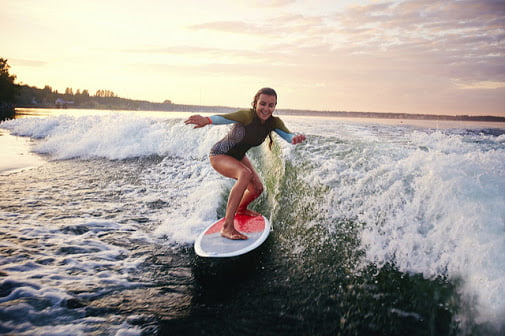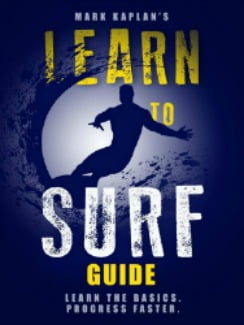How Beginners Progress Surfing
Instructor are often asked how beginners progress surfing. It is a long road of patient and regular practice. First the surfer learns the fundamentals of catching waves on soft top boards and riding straight to the beach. Then the surfer begins paddling out through waves to bigger foam waves and then small real waves.
If surfers are not able to catch most every wave and ride most waves to the beach, they need help with the fundamentals. Surfing is a series of techniques that must be applied one at a time. First the surfer rolls over on the board properly. Then he times the wave arrival and paddles hard to get in front of the wave. Then he smoothly pops up and rides straight to the beach without effort.

Learning the Surfing Fundamentals
When the surfer can catch and ride waves he has mastered the beginning steps. Any faults in this process requires more lessons, because progress requires the same fundamentals and is more challenging. Waves get bigger, move faster, have more weight, and cause bigger crashes.
The surfer paddles through waves and turns around to catch the next incoming foam wave. He uses judgement in selecting the right wave and leaves a large enough gap to properly turn around and start paddling. After the surfer can ride bigger foam waves, he should start looking for small real waves.
Real waves require different timing than foam waves. A real wave arcs in a few seconds and the surfer has to be in the arc. The wave rolls under the surf board and then the surfer paddles hard three times and puts his hands on the board. By now the pop up should be quick and smooth so as not to upset the board’s balance.
A surfer learns to angle on a wave by catching a real wave and before popping up, turning the nose towards the pocket. This minimizes pearling and gets the surfer ahead of the falling lip. Or a surfer catches real waves in the corners where the wave is smaller. The surfer paddles at a 45 degree angle towards the beach as the pocket rolls under the board and continues at that 45 degree angle in the pocket.
Have fun.
Learn More
For Oceanside Surf Lessons, see the Home Page
See the Post Surf Lessons Begin with Foam Waves
See the Post What You Learn in a 2 Hour Lesson
See the Post How to Progress in Surfing
See My Dry Land and In Water Demo video
See How to Catch a Green/Real Wave video
i have lowered my book and course prices for the lock down.
My New Surfing Course in an E-Book plus Demo Video
Get the 18 Chapter, 7,500 word Course that can prepare you for a lesson or give you the fundamentals if you are going to try it on your own. 10 years of teaching 350 students a year has given me the insights on the most precise measures you must follow for success. This course is what I teach on the dry land and in water instruction. The Course includes a 15 minute video on my dry land and in water demonstration. Only $4.95
Buy the E-book for $2.99. Learn to Surf (Different cover but same book)
Buy the Paperback on Amazon $6.95
Get Learn to Surf Course in 29 minute audio. Great prep for a lesson, reviewing after a lesson, learning on your own, refreshing after not having surfed for a while. See Table of Contents. Only $7.95

80 page Learn to Surf Book
![Surf Instructions Beginner to Advanced: Learn to Ride Waves by [Kaplan, Mark]](https://images-na.ssl-images-amazon.com/images/I/51HswFtoBQL.jpg)